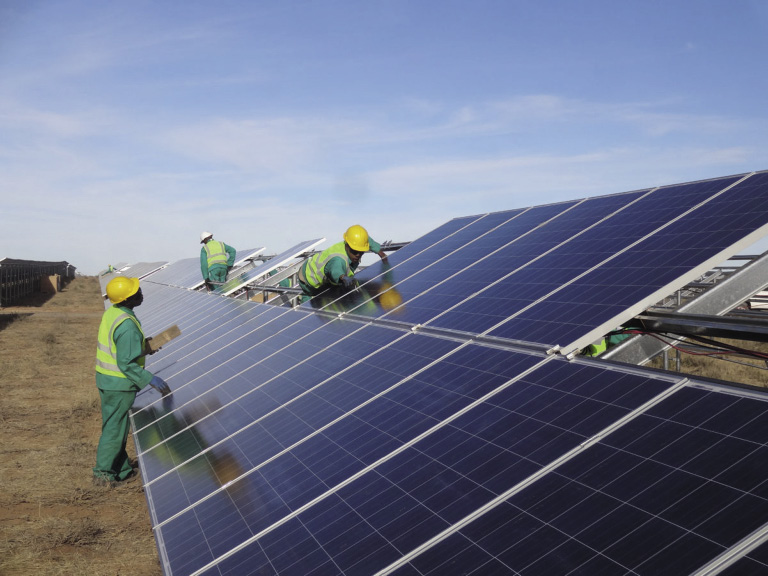The South African government-owned Development Bank of Southern Africa (DBSA) is inviting transaction advisors to apply to review the “cost effectiveness and efficacy” of the country’s decade-old Renewable Energy IPP Procurement (REIPPP) program, which handles large-scale renewable energy projects. The tender is also calling for consultants to recommend a new model.
The deadline for applications is 2 Nov. 2023.
According to the tender document, the current auction model is “expensive” for applicants and is placing a “financial burden” on the office evaluating the proposals.
The work for the successful applicant would comprise a report on the current REIPPP model and an implementation plan for a possible replacement.
The report should identify “bottlenecks” in the current program’s evaluation processes while conducting a start-to-finish review of operations. A comprehensive study on the recommended best alternative auction model is required, as well as an implementation and rollout plan spanning supporting business procedures, infrastructure, resource requirements and cost analysis.
According to Chris Ahlfeldt, an energy specialist at Blue Horizon Energy Consulting Services, the REIPPP model has received international recognition for successfully structuring a public private partnership with government and independent power producers (IPPs) that achieves both environmental and social benefits for the country.
“The REIPPP has been transparent with its procurement requirements which enabled a high degree of competition between international IPPs to source less expensive and clean electricity for South Africa,” he told pv magazine. “The program has experienced too many delays since it began in 2011 for various reasons such as Eskom opposition to government inefficiencies which has slowed the process and contributed to the current shortage of power in the country.”
According to Ahlfeldt, these delays have also limited industrialization in the country as many manufacturing facilities opened and then had to close due to lack of demand. “REIPPP also hasn’t been well integrated with Transmission Planning in the country as seen from the last procurement round when no wind projects were procured due to lack of available transmission capacity,” he added. “The lack of available transmission capacity in parts of the country with the highest resource is the biggest challenge for utility-scale solar PV currently in addition to an enabling electricity market structure with an independent transmission operator.”
Since the REIPPP program was launched in 2011, 6,422 MW of energy has been procured from 122 independent power producers in seven bid rounds, according to DBSA. Roughly 99% of projects have reached financial close.
The tender document forecasts that from 2019 to 2030, 37,696 MW of new energy projects will be added to the grid under REIPPP, with 20,400 MW comprising wind and solar.
Popular content
The issues impacting the current REIPPP program involve assessing the scale of applications and the cost of applying.
The department tasked with assessing applications, the self-funded Independent Power Producer Office, is financially burdened as “the cost of the evaluation is not proportional to the amount of megawatt procured,” the tender document states.
Due to the “extensive nature of the qualification and evaluation criteria,” the cost of participation for applicants in REIPPP has also been described as “expensive”.
“A streamlined auction process could reduce the cost of the bidding process for the IPP Office, but also reduce development costs for bidders that will be reflected in more affordable tariffs for the consumer,” the document states.
A litany of issues – such as extensive load-shedding, lack of grid capacity, failing coal-fired power stations and little progress in clean power procurement – plague South Africa’s energy sector. Despite these hurdles, however, the country recorded 5,826 MW of PV installed capacity at the end of 2022, according to the most recent data published by the International Renewable Energy Agency (IRENA).
Meanwhile, the South African energy regulator NERSA authorized the National Transmission Company of South Africa to operate a transmission system independently from troubled state-owned utility Eskom, within national boundaries. The move is part of the government's plan to split Eskom into three separate entities: Generation, Transmission, and Distribution.
Currently, Eskom remains the sole buyer of power generated under the REIPPP program.
South Africa's National Treasury is currently seeking to craft a bill to address Eskom's unsustainable ZAR 423 billion ($22.9 billion) debt with a ZAR 254 billion debt relief arrangement. The bill proposes advances of ZAR 78 billion in 2023-24, ZAR 66 billion in 2024/25, and ZAR 40 billion in 2025-26, specifically designated to cover capital and interest payments.
This content is protected by copyright and may not be reused. If you want to cooperate with us and would like to reuse some of our content, please contact: editors@pv-magazine.com.


4 comments
By submitting this form you agree to pv magazine using your data for the purposes of publishing your comment.
Your personal data will only be disclosed or otherwise transmitted to third parties for the purposes of spam filtering or if this is necessary for technical maintenance of the website. Any other transfer to third parties will not take place unless this is justified on the basis of applicable data protection regulations or if pv magazine is legally obliged to do so.
You may revoke this consent at any time with effect for the future, in which case your personal data will be deleted immediately. Otherwise, your data will be deleted if pv magazine has processed your request or the purpose of data storage is fulfilled.
Further information on data privacy can be found in our Data Protection Policy.